Presidential Impeachment and US Equity Markets
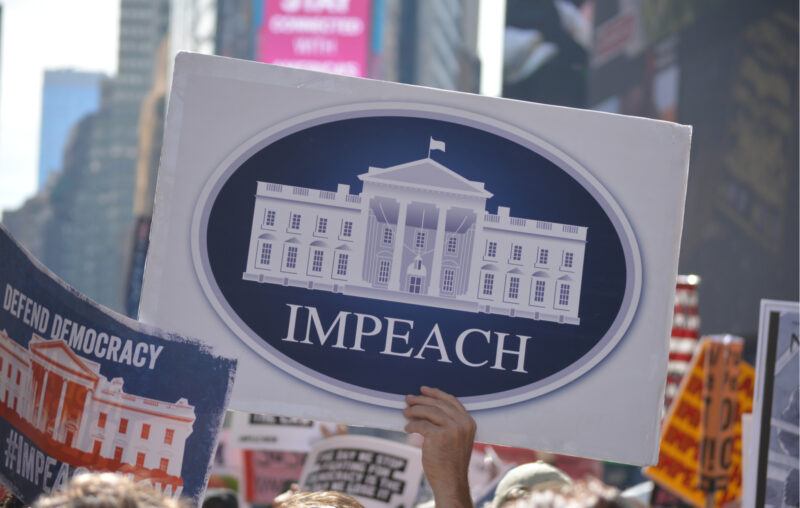
A fairly broad array of academic studies finds a connection between political stability and economic growth. As the setters and overseers of the rules of the game, elected and appointed government officials have a direct impact upon fiscal, monetary, and regulatory policy. If those policies are consistent over time and thus predictable, firms can budget and plan — which in turn sets the stage for economic growth.
Compared with other nations, the United States has a fairly consistent record of political stability, with a few brief exceptions: the American Civil War, in particular. (Even during the War of 1812, during a foreign invasion, political rule remained essentially intact.) The United States has also experienced little unforeseen presidential turnover, with a single resignation and a few impeachments. One might argue that presidential impeachments are the closest the United States ever comes to true political uncertainty.
We likely need not ask whether impeachment proceedings affect the financial markets; rather, we need to determine how impeachments affect the financial markets.
This article examines the stock market effects of presidential impeachment proceedings. But rather than jump directly to the three historical episodes (Andrew Johnson, Bill Clinton, and Donald Trump), we will first examine market reactions to three proposed elements of impeachment concerns individually, and then compare them to what equity markets actually did during and after the three impeachments. The three elements are: general uncertainty; concern about the succession of key persons; and worries specifically associated with the removal of a U.S. President (outside of elections).
Our surrogate for financial markets will be US equity indices: usually the Dow Jones Industrial Average, but occasionally others.
But first, a few caveats. One is well advised not to use the price fluctuations of stock indices, at least not alone, to draw major sociological conclusions. Second, no market moves in response to a single cause; for that reason, one cannot attribute the entirety of a move in prices, or the lack of a move, to one specific event. And finally, over the period under examination (from 1868 to 2020), the size and composure of stock markets varied greatly, as did the number of types of investors. The longer the time period between events is, the less relevant comparisons are, and thus the less weight a conclusion should carry:
General Uncertainty
The prospect of an impeachment creates great uncertainty, and uncertainty is the bane of financial markets. Because the United States is the largest economy in the world, the issuer of the world’s reserve currency, and at the center of a massive network of global trading relationships, the injection of sizable uncertainty spells concern for not only Americans but foreign governments, and global investors of all stripes.
As a first step, I examine the impact of a series of unexpected events upon the US equity markets:
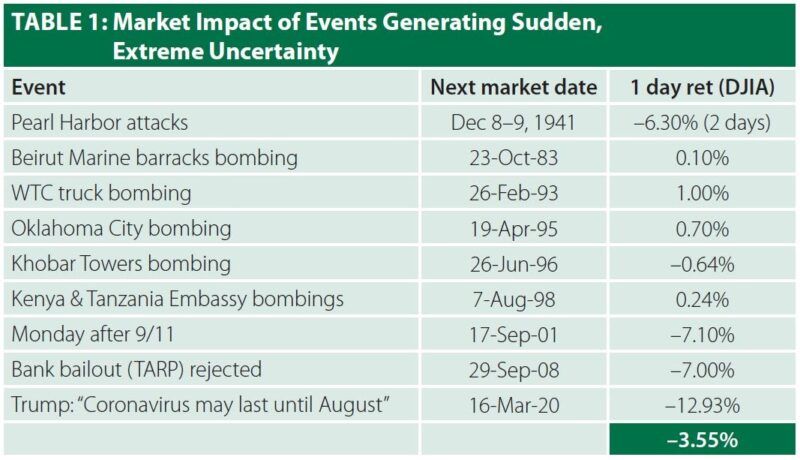
Few would be surprised to hear that financial markets are notably averse to sudden increases in unpredictability. The average decline among these events shall serve as an initial, if incomplete, benchmark.
Unexpected Removal of Key Officials
To consider the financial impact of the removal of a high-level decision maker, consider this element of impeachment by analogy: how do stock prices react when key personnel leave a company unexpectedly?
CEOs
According to CNBC anchor Jim Cramer, unexpected resignations are a major red flag for investors: “When you see unexpected resignations among key executives … maybe you should go too.” Most individuals do not leave a high-paying position they spent decades jostling for without careful consideration.
While numerous factors influence the market reaction (such as the stock performance under their tenure, the existence of a clearly-defined succession plan, etc.), consider a few such studies. Fortune (2019) reports that “companies whose CEOs departed saw their stocks’ returns drop an average of 4.19 percent in the 30 days following compared to the S&P 500.” Larcker and Tayan (2012) cover 12 CEO deaths between 1994 and 2012 and report that the stock price on the day of the executive’s death fell by 2.01 percent on average. And Salas (2010) indicates that the sudden death of a CEO leads the stock price to fall immediately by 0.64 percent on average.
Other Corporate Executives
The impact upon stock prices of the resignation or termination of other managers depends largely upon the circumstances leading up to the change. Agrawal and Chen (2008), for example, report that “stock prices decline significantly (both statistically and economically) upon news of these events” and that “firms [with internal management disputes] have poor operating performance in the years surrounding the dispute episode, and experience significantly greater incidence of stock market delisting in the years following.” They find that the cumulative average abnormal return is −2.6 percent between the day before the episode and the day after and -6.1 percent between ten days before and one day after. It is even larger, −3.9 percent or −10.3 percent, if the resigning director is an insider. Worell, Davidson, and Glascock (1993) find a statistically significant price increase of 2.3 percent in the case of forced resignations, no doubt indicating that in those cases, investors were relieved and looked ahead to an improved future. Context, as always, is pivotal.
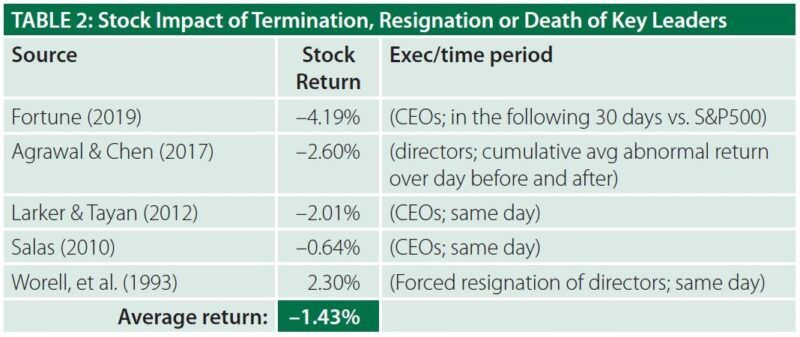
Removal of a US President (Outside Term of Office)
In addition to general uncertainty and fears arising from the removal of any key decision maker, the impeachment of a US president introduces worries unique to the circumstances surrounding the removal of an individual with significant influence over both the United States and the world at large—not only economically but geopolitically. Domestically, the impeachment introduces significant uncertainty surrounding such executive powers as the veto, the ability to issue executive orders, the tenure of Cabinet appointees, the possible abruption of policy initiatives, and more.
The unscheduled exit of a president may occur for several reasons besides impeachment: resignation, assassinations, or invocations of the 25th Amendment (concerning inability “to discharge the powers and duties of his office”). I now consider the stock market returns associated with these types of episodes.
Resignation
The day after the August 8, 1974 announcement of Nixon’s resignation, the Dow Jones Industrial Average fell 1.3 percent. (An important side note: by September 1, 1974, the index had fallen over 15 percent.)
Assassination Attempts
Several weeks before his inauguration in early 1933, an attempt was made on the life of Franklin Delano Roosevelt. Although he was unhurt, equities fell by slightly over 2 percent the next day. In September 1975 two assassination attempts were made against Gerald Ford. In the first, undertaken by former Mansonite Lynnette “Squeaky” Fromme, the weapon didn’t fire and the attempt had little if any effect on US equities. In the second, the weapon fired but Ford was unhurt; the following day, markets fell roughly 0.5 percent.
The March 1981 attempt on the life of Ronald Reagan was far more serious. Today we know that had the bullet hit a few millimeters in one direction, the wound may well have been fatal. At the time, Reagan’s injuries were described as serious but survivable, and between the time of the news release and the market’s 4:00 p.m. close, stocks fell roughly 0.25 percent. The next day, stocks rallied strongly.
Assassinations
Bearing in mind that US equity markets were orders of magnitude larger under Kennedy’s administration than under Lincoln’s, presidential assassinations have an extreme impact as they bring to the fore worries about policies and existential fears. A 2014 Harvard University paper by Baker, Frydman, and Hilt entitled “From Plutocracy to Progressivism? The Assassination of President McKinley as a Turning Point in American History” attests to the importance of worries about policy. It finds that “firms with vulnerability to antitrust prosecution saw greater decreases in their valuations following the assassination, suggesting that regulatory forbearance was an important mechanism by which firms benefited during McKinley’s Presidency.”
As for existential fears, Lincoln’s killing occurred when North-South tensions were still high following the end of the Civil War. McKinley was shot by a putative anarchist amid growing concerns about armed leftists and nihilist insurgents. Kennedy was shot when the Cold War was heating up. As Robert Stovall, then a 37-year-old director of research at the erstwhile investment bank E.F. Hutton in New York City recalled: “We thought the Kennedy assassination might be followed up by an even more serious incident. . . . We thought there might be a follow-up attack.”
How did the killings affect markets? Markets were closed the day Lincoln died (Saturday, April 15); on Monday, April 17, they fell approximately 0.7 percent. James A. Garfield was shot on July 2, 1882. That day, stocks fell 3.3 percent. (He died just short of 80 days later.) William McKinley was shot on September 6, 1901, and died 8 days later. Equities on the New York Stock Exchange fell 6.2 percent the following day. And John F. Kennedy was shot on November 22, 1963, and died shortly thereafter. Between roughly 1:30 pm and 2:07 pm EST, when trading was halted, markets fell 2.8 percent.
25th Amendment
Section 4 of the 25th Amendment involves the removal of a president who, owing to physical or mental ailments, has become unable to discharge the duties of office. While it has never been invoked, perhaps the closest approximation to the way the stock market would react is exhibited in the response to President Dwight D. Eisenhower’s heart attack while playing golf on September 24, 1955. (Today over 90 percent of individuals suffering heart attacks survive, but at that time the prospects were grimmer.) Although he survived, the Dow Jones Industrial Average fell over 6 percent after the news was broadcast.
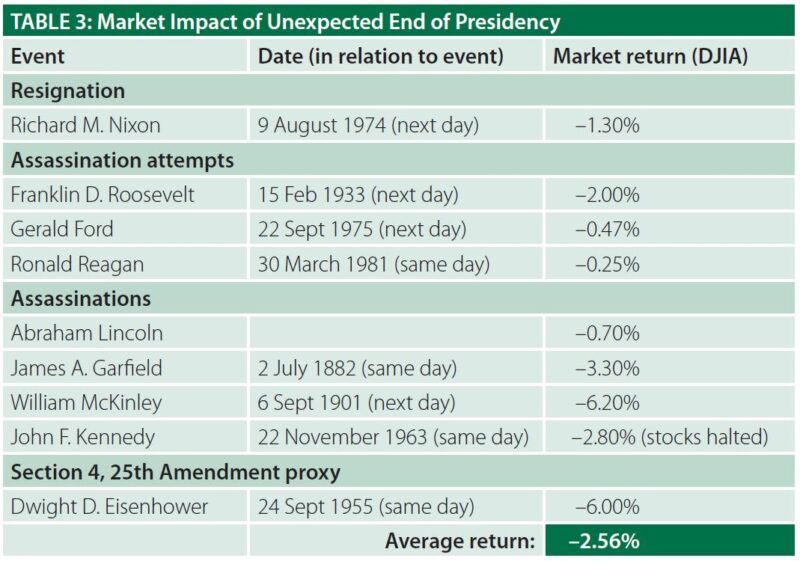
Impeachment
How have impeachments impacted markets? We have three episodes to draw on:— the impeachment trials of Andrew Johnson, Bill Clinton, and Donald Trump, all of which ended in acquittal.
Andrew Johnson
After discharging Edwin Stanton, the Secretary of War, Johnson faced 11 articles of impeachment. He was impeached in February 1868 on charges of violating the Tenure of Office Act; for voicing “intemperate, inflammatory, and scandalous harangues” and “loud threats and bitter menaces” against both Congress and the laws of the United States; and for unlawfully challenging the authority of the 39th Congress. Between May 16, 1868, and May 26, 1868, first one article and then two more were considered and failed to pass the two-thirds-majority threshold. The trial was adjourned and the remaining eight articles were dropped.
Bill Clinton
In December 1998, Clinton faced two articles of impeachment for perjury and obstructing justice related to the Monica Lewinsky scandal. On February 12, 1999, the Senate found Clinton not guilty on both articles.
Donald Trump
Trump faced two articles of impeachment (passed in December 2019): one for abuse of power, another for obstructing justice. The case centered upon the alleged withholding of military aid from Ukraine to induce an investigation of Trump’s most likely challenger in the 2020 election, former vice president Joe Biden. On February 5, 2020, the Senate found Trump not guilty on both articles.
Table 4 reports the market reactions between the date of the impeachment and the vote date(s), and again between the vote date and two months later. .
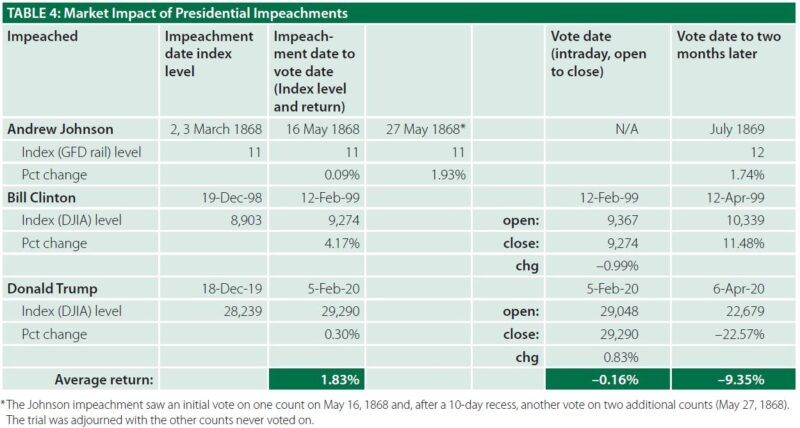
Findings and Conclusion
Granted that this is a ‘quick-and-dirty’ study rife with hidden variables and a small-n problem (only three impeachments, with one almost a century and a half before the other two), the results show straightforward, virtually uniform average negative responses among the a la carte market reactions to general uncertainty, key person/business continuity concerns, and presidentially-unique market events. And yet the behavior of equity indices with respect to the three presidential impeachments is mostly languid between both the impeachment date and the vote date (with the exception of the Clinton impeachment, during which a strong bull market ran), and intraday on the day of the vote.
But this makes perfect sense. For one thing, impeachments involve a sequential process, with updates trickling out over time. As market participants acquire information, they continually assess and revise their expectations regarding the likelihood of conviction (and possible removal from office), trading and adjusting their stock positions accordingly. Unlike terrorist attacks, management shake-ups, or assassinations — each of which bring a burst of precariousness — impeachments are characterized by proceedings through which news is slowly but steadily incorporated into stock prices: a fairly persuasive display of the efficient market hypothesis in action. For another thing, knowing that conviction requires a two-thirds majority in the Senate allows observers to discount the outcome well in advance of a vote.
Compare the market reactions to impeachment with the demise of a well-regarded corporate executive: Steve Jobs of Apple, Inc. Before he died in October 2011, he had been on sick leave for months and his uncertain health had been a drag on Apple’s stock performance. When it was reported that he finally passed away, the stock fell only 0.2 percent, no doubt in part because expectations of his demise had mostly been priced into the stock. Not dissimilarly, the average intraday index return on the day of impeachment votes is a similarly insouciant -0.16%.
Another conclusion can be drawn; this one from the two-month post-impeachment equity index returns: +1.74 percent for Johnson; +11.48 percent for Clinton; and −22.57 percent for Trump. In the case of Clinton, markets were still well within a bull market, in particular in technology stocks; and in the case of Trump, not long after the impeachment vote the coronavirus pandemic struck the market (and the world). From the perspective of the markets, impeachment outcomes tend to fade quickly, with attention rapidly shifting back to macroeconomic issues.
Equity market reactions associated with the proposed constituents of impeachment concerns — general uncertainty, removal of a key decision maker, and uneasiness specifically relating to the removal of the top political executive in the United States — do not approximate what actually occurs during and after impeachment trials. Each impeachment case is idiosyncratic and delivers unique financial market outcomes. In any event, the gradual pace of what is fundamentally a political (as opposed to legal) action tends to result in dampened, rather than heightened, volatility. And nearly as soon as any latent uncertainties are ironed out, broader economic trends resume driving the direction of financial markets. A more profound degree of political upheaval, with a more sudden onset, is required to throttle the stock markets.
Originally published in Financial History Issue 134 (Summer 2020), the periodical of the Museum of American Finance. On the occasion of the second impeachment of former President Donald J. Trump, a fourth anecdote will eventually be added to this study.
References
Agrawal, A., & Chen, M. A. (2017). Boardroom brawls: An empirical analysis of disputes involving directors. Quarterly Journal of Finance, 7(03), 1750006.
Baker, R. B., Frydman, C., & Hilt, E. (2014). From Plutocracy to Progressivism?: The Assassination of President McKinley as a Turning Point in American History. Harvard University.
Larcker, D. F., & Tayan, B. (2012). Sudden Death of a CEO: Are Companies Prepared When Lightning [sic] Strikes?. Rock Center for Corporate Governance at Stanford University, Closer Look Series: Topics, Issues and Controversies in Corporate Governance No. CGRP-24.
Salas, J. M. (2010). Entrenchment, governance, and the stock price reaction to sudden executive deaths. Journal of banking & finance, 34(3), 656-666.
Stathis, S. W., & Huckabee, D. C. (1998). Congressional Resolutions on Presidential Impeachment: A Historical Overview. Congressional Research Service, Library of Congress.
Worrell, D. L., Davidson III, W. N., & Glascock, J. L. (1993). Stockholder reactions to departures and appointments of key executives attributable to firings. Academy of Management Journal, 36(2), 387-401.
“Cramer’s Investing Rule for When Company Executives Unexpectedly Resign.” Yahoo! Finance, Yahoo!, finance.yahoo.com/news/cramer-apos-investing-rule-company-223000352.html.
Sraders, Anne. “CEO Exodus: Here’s What Happens to a Company’s Stock Price When There’s Turnover at the Top.” Fortune, Fortune, 24 Oct. 2019, fortune.com/2019/10/23/ceo-exodus-heres-what-happens-to-a-companys-stock-price-when-theres-turnover-at-the-top/.
“JFK Shot: How Wall Street Reacted 50 Years Ago.” Ed’s Eye on the Economy – Newsletters about Financial Planning in PA & NJ, CFP, RIA, Kohlhepp Investment Advisors – Kohlhepp Investment Advisors, www.kohlheppadvisors.com/ed-s-head/ed-s-eye-on-the-economy/entry/jfk-shot-how-wall-street-reacted-50-years-ago.
Taylor, Bryan. “The Stock Market and the Impeachment of Andrew Johnson.” Global Financial Data, 21 Oct. 2019, www.globalfinancialdata.com/the-stock-market-and-the-impeachment-of-andrew-johnson/.









